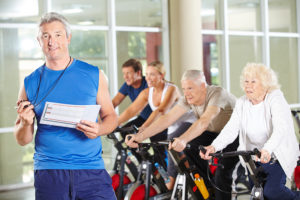 Aerobic exercise is key for senior health. If you’re not getting your heart rate up and breaking a sweat, does it count as exercise? To get life extension and disease protection benefits, seniors need aerobic exercise, 150 minutes a week.
Aerobic exercise is key for senior health. If you’re not getting your heart rate up and breaking a sweat, does it count as exercise? To get life extension and disease protection benefits, seniors need aerobic exercise, 150 minutes a week.
Sure, it’s important to find activities that offer movement and fun and are playful in nature. But don’t avoid things that get you a little out of breath. That’s when you’ll get the real benefits. Even most heart conditions will improve with activity. Of course, check with your doctor and be wise.
We love tennis. You run, stop, go, hit the ball (hopefully) and then repeat. It is a sport, it is play. While you’re having fun, the biggest winner is your body. And your brain. If tennis is too rigorous, try Pickleball or Ping Pong.
There are many other activities that offer play value masquerading as exercise, and all these take your mind off exercise you may perceive as boring or repetitive. This is especially important for seniors: years of stress, exposure to toxins, medications, lack of exercise—make us more susceptible to heart disease, so keeping our heart healthy is critical.
The Benefits of Aerobic Exercise for Seniors
Aerobic exercise―also called cardio or cardiovascular workouts―include jogging, swimming, cycling, walking, dancing, and anything that gets your heart rate up. Known to reduce anxiety and depression, this type of exercise boosts mood, in part by increasing blood flow to the brain. You see, exercise affects the hypothalamic-pituitary-adrenal (HPA) axis and, thus, reduces stress.
This involves several regions of the brain, including the limbic system, which controls motivation and mood, the amygdala, which generates emotional responses to stress, and the hippocampus, which plays an important part in memory formation as well as in mood and motivation. Here’s a little video that explains the HPA axis:
Your Normal Resting Heart Rate
If you want to enjoy the benefits of aerobic exercise for seniors, start by finding your normal resting heart rate. Your resting heart rate is the number of times your heart beats per minute when you’re at rest. Generally speaking, a lower heart rate is better. For most seniors, between 60 and 100 beats per minute (bpm) is normal.
Of course, some conditions and medications may affect heart rate, meaning you may have a lower maximum heart rate and target zone. The rate can also be affected by factors like stress, anxiety, hormones and how physically active you are. For example, an athlete or more active person may have a resting heart rate as low as 50 beats per minute. If you have a heart condition or take medication, ask your healthcare provider what your heart rate should be.
To find your resting heart rate:
- Take your pulse on the inside of your wrist, on the thumb side.
- Use the tips of your first two fingers (not your thumb) and press lightly over the artery.
- Count your pulse for 30 seconds and multiply by 2 to find your beats per minute.
Your Target Heart Rate
Your target heart rate, meaning, the rate your heart should beat during aerobic exercise, helps you get the maximum benefit from every step, swing and squat. Generally speaking, maximum heart rate is about 220 minus your age. Your target heart rate during moderate intensity activities is about 50-70% of maximum heart rate, while during vigorous physical activity it’s about 70-85% of maximum.
According to the American Heart Association:
| Age | Target Heart Rate Zone: 50-85% | Avg. Max Heart Rate: 100% |
| 60 years | 80-136 bpm | 160 bpm |
| 65 years | 78-132 bpm | 155 bpm |
| 70+ years | 75-128 bpm | 150 bpm |
As you exercise, periodically check your heart rate manually or with a fitness tracker. If your heart rate is too high, lower your pace. For anyone new to aerobic exercise, I recommend aiming for the lower range of your target zone (50 percent) and gradually building up.
Whatever activity or sport you choose, you don’t have to be a natural-born athlete to enjoy it. The important thing is to get out there and do it! In time, you’ll be able to comfortably engage in aerobic exercise for seniors at up to 85 percent of your maximum heart rate.

Recent Comments